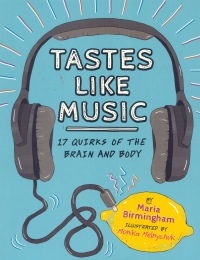| ________________
CM . . .
. Volume XXI Number 14 . . . . December 5, 2014
excerpt:
This new nonfiction book by Birmingham (a contributor to OWL and ChickaDEE Magazine) will appeal to older elementary school kids who are interested in the human body or the Ripley’s Believe it or Not series. The 17 mysteries of the human body that are featured in this book include interviews with people who live with synesthesia (experiencing two senses at once), prosopagnosia (face blind), supertasting, developmental topographic disorientation, and highly superior autobiographical memory. Comprehensive definitions, pronunciation guides, descriptions that incorporate facts, dates, and research, and various colourful sidebars and cartoon drawings help expand on the main topics. The idea of this book may have been inspired by the author’s own personal situation; she doesn’t have a sense of smell (congenital anosmia). Birmingham devotes two pages to her disorder as she does with the others in the book. Many of the disorders are neurological, but a few, such as hyperdontia (extra teeth) and joint hypermobility, are oddities of the body. Information about what is “average” helps the reader understand why these curiosities are rare (Baby teeth usually start to appear around six months of age, and most permanent teeth are in place by around age twelve. But for those with a condition called hyperdontia, permanent teeth don’t develop at all. These individuals often have to live with several baby teeth into adulthood). The book doesn’t contain actual photographs, only cartoon illustrations. In her text, the author tries to include both positive and negative information about the conditions. This book makes the reader appreciate the design and complexity of the human body and mind. Back material includes a small index and list of consultants who advised the author during the writing of this book. Recommended. Tanya Boudreau is a librarian at the Cold Lake Public Library in Cold Lake, AB.
To comment on this title or this review, send mail to cm@umanitoba.ca.
Copyright © the Manitoba Library Association. Reproduction for personal use is permitted only if this copyright notice is maintained. Any
other reproduction is prohibited without permission.
CM Home | Next Review | Table of Contents for This Issue - December 5, 2014 | Back Issues | Search | CM Archive | Profiles Archive |
